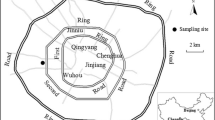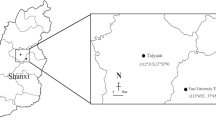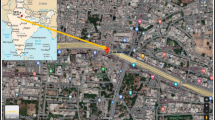Abstract
Fine particulate matters (PM2.5) samples were collected in Xi’an, northwestern China, from May 2015 to April 2016. The concentrations, seasonal variations, potential sources, and health risks for personal exposure for ten metallic elements (i.e., Ba, Zn, Cu, As, Ni, Pb, Mn, Cr, Cd, and Hg) bounded to PM2.5 were determined and assessed in this study. The results showed that the average PM2.5 mass concentration in Xi’an was 62.1 ± 35.0 μg m−3 during the sampling period. The annual concentration of the total quantified elements was 2459.5 ± 1789.8 ng m−3, with relatively higher values in winter (3334.9 ± 1690.9 ng m−3) and spring (2809.4 ± 2465.4 ng m−3), in comparison of those in summer (1857.6 ± 1162.7 ng m−3) and autumn (1252.5 ± 842.4 ng m−3). Two elements of Ba (678.0 ± 684.9 ng m−3) and Zn (1264.8 ± 725.3 ng m−3) had greater fluctuations in concentrations and were accounted for more than 80% of the concentration of total quantified elements for each season. The concentrations of As in Xi’an exceeded the national standard in China. The enrichment factors (EFs) of most target heavy metals were high, exceeding 100 for Zn, As, Pb, Cd, and Hg, attributed to strong influences from human activities. Moreover, the largest enrichment of heavy metals in PM2.5 occurred in Xi’an in winter. Principle component analysis (PCA) was applied for source apportionment. Coal and other fuel combustion, vehicle exhaust, and industrial activities were the three major pollution sources which contributed 43.6, 29.9, and 15.3%, respectively, of the total variance of PM2.5. The health risk assessment showed that the non-cancer risks of As, Pb, and Cr for children were greater than 1, as well as of As for adults. The cancer risks of As and Cr were higher than 1 × 10−6, indicating that the two elements had high potentials for both non-cancer and cancer risks. Our finding suggests that the PM2.5 and related heavy metal pollutions in Xi’an were serious and posed high potential health risks. Effective controls and measures should be established in the studied area.




Similar content being viewed by others
References
Adachi K, Tainosho Y (2004) Characterization of heavy metal particles embedded in tire dust. Environ Int 30(8):1009–1017
Air Quality Guidelines, Particulate matter, ozone, nitrogen dioxide and sulfur dioxide (2006) World Health Organization. WHO press. Geneva
Ajmone MF, Biasioli M, Kralj T, Grčman H, Davidson CM, Hursthouse AS, Madrid L, Rodrigues S (2008) Metals in particle–size fractions of the soils of five European cities. Environ Pollut 152:73–81
Ambient air quality standards of the People’s Republic of China (GB 3095–2012) (2012) Ministry of Environmental Protection of the People’s Republic of China. Beijing
Cao JJ, Shen ZX, Chow JC, Watson JG, Lee SC, Tie XX, Ho KF, Wang GH, Han YM (2012) Winter and summer PM2.5 chemical compositions in fourteen Chinese cities. J Air Waste Manage Assoc 62(10):1214–1226
Charlesworth S, Miguel ED, Ordonez A (2011) A review of the distribution of particulate trace elements in urban terrestrial environments and its application to considerations of risk. Environ Geochem Health 33:103–123
Chen SH, Sun TH, Zhou QX, Wu GP (2002) Interaction between microorganisms and heavy metals and its application. Chin J Appl Ecol 13(2):239–242 (in Chinese with English abstract)
Chen H, Lu XW, Chang YY, Xue WZ (2014) Heavy metal contamination in dust from kindergartens and elementary schools in Xi’an, China. Environ Earth Sci 71:2701–2709
Chen PF, Bi XH, Zhang JQ, Wu JH, Feng YC (2015) Assessment of heavy metal pollution characteristics and human health risk of exposure to ambient PM2.5 in Tianjin, China. Particuology 20:104–109
Deng FL (2008) Analysis on the change of precipitation in Xi’an in the last 57 years. Shaanxi Meteorology 4:21–23 (in Chinese)
Du JH, Zhang YS, He LY (2012) Pollution characteristics and health risk assessment of heavy metals in Shenzhen atmospheric PM2.5. J Environ Health 29(9):838–840 (in Chinese)
Fang GC, Huang YL, Huang JH (2010) Study of atmospheric metallic elements pollution in Asia during 2000–2007. J Hazard Mater 180:115–121
Ferreira BL, De ME (2005) Geochemistry and risk assessment of street dust in Luanda, Angola: a tropical urban environment. Atmos Environ 39:4501–4512
General Administration of Quality Supervision Inspection and Quarantine of the People’s Republic of China. Reference Material Certificate, Soil composition analysis standard material (GBW07401–GBW07408) (2003) Geophysical and Geochemical Exploration Research Institute: Langfang, China
Han Y, Du P, Cao J, Posmentier ES (2006) Multivariate analysis of heavy metal contamination in urban dusts of Xi’an, Central China. Sci Total Environ 355:176–186
He GX, Feng H, Zhang HR (2014) The diffusion and attenuation model of PM2.5 pollution in air. Mathematics Practice Theory 455:107–118
Hu X, Zhang Y, Ding ZH, Wang TJ, Lian HZ, Sun YY, Wu JC (2012) Bio-accessibility and health risk of arsenic and heavy metals (Cd, Co, Cr, Cu, Ni, Pb, Zn and Mn) in TSP and PM2.5 in Nanjing, China. Atmos Environ 57:146–152
Hu CW, Chao MR, Wu KY (2003) Characterization of multiple airborne particulate metals in the surroundings of a municipal waste incinerator in Taiwan. Atmos Environ 37(20):2845–2552
Jiao L, Shen JD, Yao L, Yang L (2013) Pollution characteristics and sources of heavy metals in atmospheric dust fall of Hangzhou. Environ Pollution Control 35(1):73–76 (in Chinese with English abstract)
Jodeh S, Hasan AR, Amarah J, Judeh F, Salghi R, Lgaz H, Jodeh W (2018) Indoor and outdoor air quality analysis for the city of Nablus in Palestine: seasonal trends of PM10, PM5.0, PM2.5, and PM1.0 of residential homes. Air Quality, Atmosphere Health 11:229–237
Kan HD, Chen RJ, Tong SL (2012) Ambient air pollution, climate change, and population health in China. Environ Int 42(1):10–19
Kong SF, Lu B, Ji YQ, Zhao XY, Bai ZP, Xu YH, Liu Y, Jiang H (2012) Risk assessment of heavy metals in road and soil dusts within PM2.5, PM10 and PM100 fractions in Dongying city, Shandong Province, China. J Environ Monit 14:791–803
Kong SF, Ji YQ, Lu B, Chen L, Han B, Li ZY, Bai ZP (2011) Characterization of PM10 source profiles for fugitive dust in Fushun—a city famous for coal. Atmos Environ 45:5351–5365
Kong SF, Li L, Li XX, Yin Y, Chen K, Liu DT, Yuan L, Zhang YJ, Shan YP, Ji YQ (2015) The impacts of firework burning at the Chinese Spring Festival on air quality: insights of tracers, source evolution and aging processes. Atmos Chem Phys 15:2167–2184
Khan MF, Hwa SW, Hou LC, Mustaffa NLH, Amil N, Mohamad N, Sahani M, Jaafar SA, Nadzir MSM, Latif MT (2017) Influences of inorganic and polycyclic aromatic hydrocarbons on the sources of PM2.5 in the Southeast Asian urban sites. Air Quality, Atmosphere Health 10(8):999–1013
Khan MF, Latif MT, Saw WH, Amil N, Nadzir MSM, Sahani M, Tahir NM, Chung JX (2016) Fine particulate matter in the tropical environment: monsoonal effects, source apportionment, and health risk assessment. Atmospheric Chemistry Physics 16(2):597–617
Lee H, Allen HC (2012) Analytical measurements of atmospheric urban aerosol. Anal Chem 84(3):1196–1201
Lin XH, Zhao Y, Fan XJ, Hu GR, Yu RL (2016) Enrichment characteristics and sources analysis of metal elements in PM2.5 in autumn in Nanchang city. Environ Sci 37(1):35–40
Liu R, Zhang H, Gou X, Luo XQ, Yang HY (2014) Approaches of health risk assessment for heavy metals applied in China and advance in exposure assessment models: a review. Ecology Environ Sci 23:1239–1244
Liu PP, Lei YL, Ren HR, Gao JJ, Xu HM, Shen ZX, Zhang Q, Zheng CL, Liu HX, Zhang RJ, Pan H (2017a) Seasonal variation and health risk assessment of heavy metals in PM2.5 during winter and summer over Xi’an, China. Atmosphere 8(6):91
Liu XH, Guo JE, Ma LG, Su B, Zhao HF, Lu JM, Lu Q (2017b) Analysis on source of heavy metal elements in PM2.5, Taiyuan city 2016. Prev Med Tribune 23(8):564–567
Lu XW, Li LY, Wang LJ, Lei K, Huang J, Zhai YX (2009) Contamination assessment of mercury and arsenic in roadway dust from Baoji, China. Atmos Environ 43:2489–2496
Manalis N, Grivas G, Protonotarios V, Moutsatsou A, Samara C, Chaloulakou A (2005) Toxic metal content of particulate matter (PM10), within the Greater Area of Athens. Chemosphere 60(4):557–566
Meng YT, Zhang YM, Li M (2009) Biogenic Mn oxides for effective desorption of Cd from aquatic environment. Environ Pollut 157:2577–2583
Mohsenibandpi A, Eslami A, Ghaderpoori M, Shahsavani A, Jeihooni AK, Ghaderpoury A, Alinejad A (2018) Health risk assessment of heavy metals on PM2.5 in Tehran air, Iran. Data Brief 17:347–355
National Bureau of Statistics of the People’s Republic of China (2017) China Statistical Yearbook, 2016, China Statistics Press: Beijing, China
Okuda TK, Masayuki N, Daisuke N (2008) Trends in hazardous trace metal concentrations in aerosols collected in Beijing, China from 2001 to 2006. Chemosphere 72(6):917–924
Oliva SR, Espinosa AJF (2007) Monitoring of heavy metals in top soils, atmospheric particles and plant leaves to identify possible contamination sources. Microchem J 86(1):131–139
Qiu ZW, Xu XQ, Liu WY, Li XX (2018) Investigation into pedestrian exposure to traffic PM around grade separations: a case study in Xi’an, China. Air Quality, Atmosphere & Health PP 1–13
Rastogi N, Singh A, Singh D, Sarin MM (2014) Chemical characteristics of PM2.5 at a source region of biomass burning emissions: evidence for secondary aerosol formation. Environ Pollut 184(1):563–569
Shen ZX, Zhang Q, Cao JJ, Zhang LM, Lei YL, Huang Y, Huang RJ, Gao JJ, Zhao ZZ, Zhu CS, Yin XL, Zheng CL, Xu HM, Liu SX (2017) Optical properties and possible sources of brown carbon in PM2.5 over Xi’an, China. Atmos Environ 150:322–330
Taylor SR, Mclennan SM (1995) The continental crust: its composition and evolution. An examination of the geochemical record preserved in sedimentary rocks, Blackwell Scientific Publications: Boston
Tokalioglu S, Kartal S (2006) Multivariate analysis of the data and speciation of heavy metals in street dust samples from the Organized Industrial District in Kayseri (Turkey). Atmos Environ 40:2797–2805
USEPA (1989) Risk Assessment Guidance for Superfund. Part A, Human Health Evaluation Manual. Part E, Supplemental Guidance for Dermal Risk Assessment, Part F, Supplemental Guidance for Inhalation Risk Assessment. Available on–line at, https://www.epa.gov/risk/risk–assessment–guidance–superfund–rags–part
USEPA (1996) Soil screening guidance: technical background document. In: Office of soild waste and emergency response, Washington, DC
USEPA (2001) Supplemental guidance for developing soil screening levels for superfund sites. In: Office of soild waste and emergency response, Washington, DC
USEPA (2007) Framework for metals risk assessment. In: Office of Soild Waste and Emergency Response. USA, Washington, DC
USEPA (2011) Exposure Factors Handbook: 2011 Edition. USA Office of Research and Development, Washington, DC 20460
Vallius M, Janssen NAH, Heinrich J, Hoek G, Ruuskanen J (2005) Source and elemental composition of PM2.5 in three European cities. Sci Total Environ 337:147–162
Wang P, Cao JJ, Shen ZX, Han YM, Lee SC, Huang Y, Zhu CS, Wang QY, Xu HM, Huang RJ (2015) Spatial and seasonal variations of PM2.5 mass and species during 2010 in Xi’an, China. Sci Total Environ 508:477–487
Wang Y, Zhuang GS, Tang AH, Hui Y, Sun YL, Chen S, Zheng AH (2005) The ion chemistry and the source of PM2.5 aerosol in Beijing. Atmos Environ 39(21):3771–3784
Wang J, Hu ZM, Chen YY (2013) Contamination characteristics and possible sources of PM10 and PM2.5 in different functional areas of Shanghai, China. Atmos Environ 68:221–229
Wei BG, Yang LS (2010) A review of heavy metal contaminations in urban soils, urban road dusts and agricultural soils from China. Microchem J 94:99–107
Witkowska A, Lewandowska AU, Saniewska D, Falkowska LM (2016) Effect of agriculture and vegetation on carbonaceous aerosol concentrations (PM2.5 and PM10) in Puszcza Borecka National Nature Reserve (Poland). Air Quality, Atmosphere Health 9(7):761–773
Xu HM, Ho SSH, Cao JJ, Guinot B, Kan HD, Shen ZX, Ho KF, Liu SX, Zhao ZZ, Li JJ, Zhang NN, Zhu CS, Qian Z, Huang RJ (2017) A 10-year observation of PM2.5-bound nickel in Xi’an, China: effects of source control on its trend and associated health risks. Sci Rep 7:41132
Xu Y, Ying Q, Hu JL, Gao Y, Yang Y, Wang DX, Zhang HL (2018) Spatial and temporal variations in criteria air pollutants in three typical terrain regions in Shaanxi, China, during 2015. Air Quality Atmosphere Health 11(1):95–109
Zhang M, Wang H (2009) Concentrations and chemical forms of potentially toxic metals in road–deposited sediments from different zones of Hangzhou, China. J Environ Sci 21(5):625–631
Zhang N, Han B, He F, Xu J, Niu C, Zhou J, Kong SF, Bai ZP (2015) Characterization, health risk of heavy metals, and source apportionment of atmospheric PM2.5 to children in summer and winter: an exposure panel study in Tianjin, China. Air Quality, Atmosphere Health 8:347–357
Zhen XR (2015) Analysis on the cause of a continuous pollution process in Shanghai in spring. Shanghai urban environmental and meteorological center, Shanghai.
Zheng N, Liu JS, Wang QC, Liang ZZ (2010) Health risk assessment of heavy metal exposure to street dust in the zinc smelting district, Northeast of China. Sci Total Environ 408:726–733
Zheng XY, Liu XD, Zhao FH, Duan FK, Yu T, Cachier H (2005) Seasonal characteristics of biomass combustion and emission contribution to atmospheric particulates in Beijing. Science China 35(4):346–352 (in Chinese with English abstract)
Acknowledgments
This study was supported from the open fund by the State Key Laboratory of Loess and Quaternary Geology, Institute of Earth Environment, CAS (SKLLQG1722, SKLLQG1712) and the open fund by the Jiangsu Key Laboratory of Atmospheric Environment Monitoring and Pollution Control (KHK1712), a Project Funded by the Priority Academic Program Development of Jiangsu Higher Education Institutions (PAPD).
Author information
Authors and Affiliations
Corresponding author
Electronic supplementary material
ESM 1
(DOC 80 kb)
Rights and permissions
About this article
Cite this article
Liu, P., Ren, H., Xu, H. et al. Assessment of heavy metal characteristics and health risks associated with PM2.5 in Xi’an, the largest city in northwestern China. Air Qual Atmos Health 11, 1037–1047 (2018). https://doi.org/10.1007/s11869-018-0598-9
Received:
Accepted:
Published:
Issue Date:
DOI: https://doi.org/10.1007/s11869-018-0598-9




